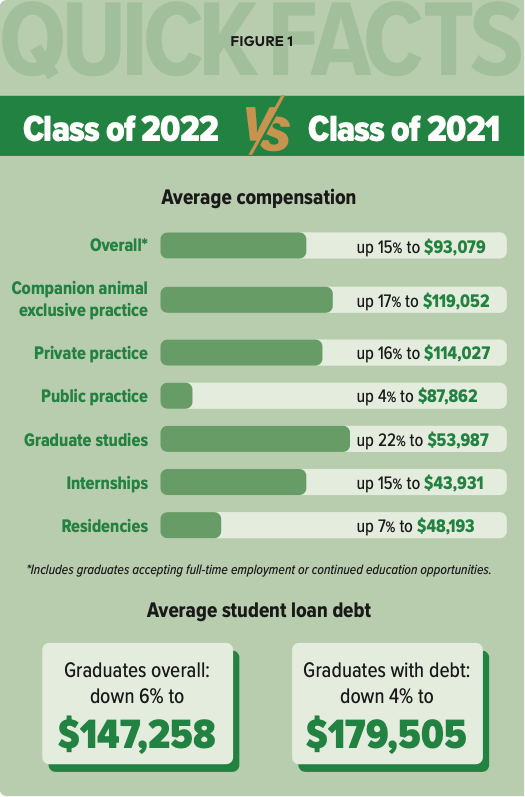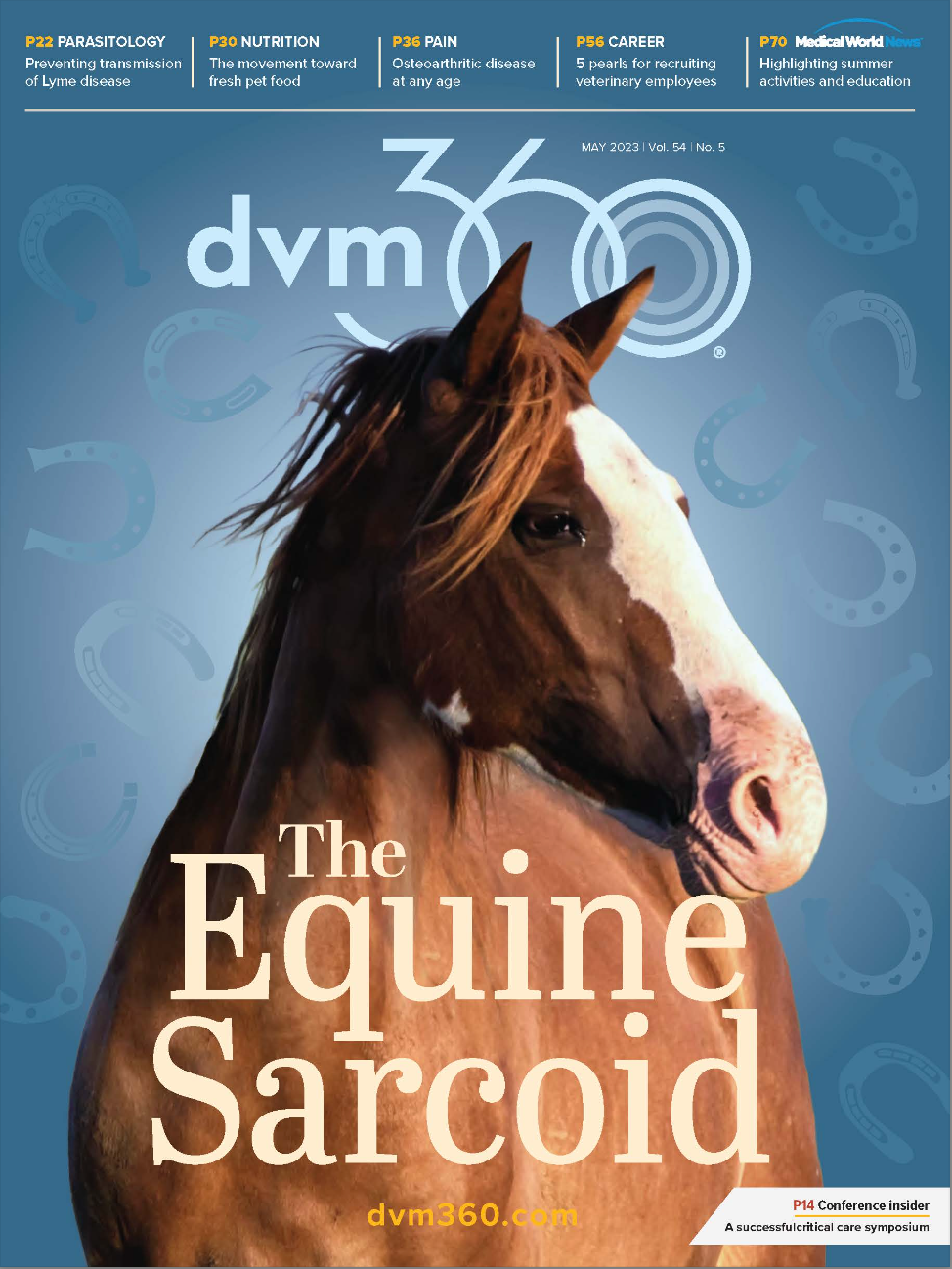Recent veterinary graduate compensation up, debt down
Evidence suggests we’re making headway regarding the financial health of veterinarians, but we’re not out of the woods

In this time of economic turbulence, it’s nice to have some good news to share. It’s even better when the news touches on issues that are key to the health and viability of the veterinary profession.
Full-time employment of new veterinary school graduates has reached a 22-year high. Almost all 2022 veterinary graduates who participated in the 2022 American Medical Veterinary Association (AVMA) Senior Survey landed full-time employment or an opportunity for advanced education before graduating.1 And with robust demand for veterinarians, they are being paid more. Starting compensation climbed significantly between 2021 and 2022 (Figure 1), although with the effects of inflation, the increase only brought us back in line with trends seen before the 2008 financial crisis.
However, the good news is also what’s down. After a peak in 2020, student debt levels have declined for 2 consecutive years, falling to a point last seen before 2018.
What do these changes mean?
The combination of higher pay and lower debt translates to a noteworthy reduction in the average debt-to-income ratio for new graduates securing full-time employment—from 1.70 in 2021 to 1.44 in 2022 (Figure 2). This ratio measures a newly graduated veterinarian’s capacity to pay down their student loans and is calculated using data from new graduates who report both salary and debt numbers.

The evidence suggests we’re making headway regarding the financial health of veterinarians, but we’re not out of the woods. The 2022 debt-to-income ratio of 1.44 takes us closer to the 1.4 figure considered serviceable for US domestic veterinary graduates without posing serious financial stress.2 However, more than a quarter of new graduates in 2022 had a debt-to-income ratio of 2.0 or more.
And although the news is encouraging for new graduates, it’s less so for veterinarians who graduated with debt before 2022, when debt-to-income ratios were higher. According to the AVMA’s annual census of veterinarians, there’s been little progress in the average veterinarian’s income, which remained below 2008 levels in 2022 after adjusting for inflation.1
To support future progress in combating debt, it could help to understand what's driving the current decrease in debt for new graduates. The answer is likely complex. The explanation isn't tuition, which increased while the class of 2022 was in school, despite the COVID-19 pandemic freezes by some veterinary schools.3 However, it may involve funding sources. The amount of tuition, fees, and living expenses paid by family or from personal savings has risen, up at least 2 percentage points for all 2022 graduates, including those with debt, compared with the class of 2020.
How can we sustain the momentum of decreasing debt?
Several ideas have been proposed to reduce the debt-to-income ratio of new graduates and to manage debt after graduation.4 Many involve changes by academic institutions, employers, loan providers, and legislators, with potential large-scale impacts. One key pillar of the AVMA’s work involves initiatives aimed at improving the financial health of veterinarians. There also are actions we can take as individuals to support our own financial health, and, by extension, our ability to thrive in a rewarding career.
Know your worth and request a salary to match
Potential income might not have topped any of our lists of reasons for becoming a veterinarian, but it’s certainly important for thriving after graduation.
Whether considering a new job or asking for a raise, it pays to research what others are earning in similar fields, with similar experience and qualifications, in similar locations, and to use the average value as a starting point. If you’ve graduated within the past 6 years, the AVMA’s salary estimator tool for new and early-career veterinarians found at myvetlife.avma.org can research this for you very quickly. Other information sources include the 2023 AVMA Report on the Economic State of the Veterinary Profession, US Bureau of Labor Statistics, and websites like Glassdoor or DataUSA.
Take advantage of loan repayment programs
You might have already heard about these, but it bears repeating. Several loan forgiveness programs are available to help veterinarians repay federal or private student loans, including income-driven repayment plans for federal loans, the Public Service Loan Forgiveness Program, the Veterinary Medicine Loan Repayment Program, and others. Learn more about these programs at avma.org/LoanRepayment. Your employer also may offer some assistance.
Seek financial advice
Research shows that veterinarians who engage with a financial adviser can pay off student debt faster than others.5 An added bonus is that those veterinarians also score better on measures of well-being.5 A good place to find an adviser is the National Association of Personal Financial Advisors (NAPFA.org). This organization lists fee-based advisers who act in their clients’ best interests and cannot accept compensation (eg, commissions) from any source other than their clients.
For other help, the AVMA offers a suite of resources with tips and advice to support your financial health at avma.org/PersonalFinance. And to help you quickly understand the ins and outs of loan repayment strategies, MyVeterinaryLife.com has a series of newly updated learning modules covering interest rates, capitalization, the effects of marriage, current government proposals for student debt relief, and more.
Add your voice to AVMA's student debt advocacy
In Washington, the AVMA works closely with lawmakers to support programs that alleviate veterinary student debt and to oppose policies that would worsen it. Key priorities include establishing more favorable refinancing options, lowering interest rates, and protecting and improving Public Service Loan Forgiveness, among many others. You can help by signing up for the AVMA Congressional Advocacy Network and using the easy tools available there to let your members of Congress know these matters are important to you. Find other ways to get involved in advocacy here.
Leverage scholarships and grants
Remind veterinary students you know that scholarships and other funding support are available from a wide variety of sources and encourage them to apply. Data from the AVMA Senior Survey suggest that 2022 graduates were less likely to use scholarships to fund their education than their predecessors in 2021 or 2020, potentially leaving awards unclaimed. A comprehensive list of veterinary scholarships and grants is kept by AVMF.6 Substantial funding is also available from the US Army Veterinary Corps or US Department of Agriculture in return for fulfilling certain obligations.
References
- Bain B, Ouedraogo F, Hansen C. 2023 AVMA Report on the Economic State of the Veterinary Profession. AVMA; 2023.
- Bain B, Salois M, Ouedraogo F, Hansen C, Dutton B. 2018 AVMA & AAVMC Report on the Market for Veterinary Education. American Veterinary Medical Association. October 2018. Accessed April 25, 2023. www.avma.org/sites/default/ files/resources/2018-econ-rpt1-veterinary-education.pdf
- Public data. American Association of Veterinary Medical Colleges. Accessed March 24, 2023. www.aavmc.org/ about-aavmc/public-data
- Harris DL, Chaddock HM. The challenge of “fixing the debt”: recommendations from the summit. J Vet Med Educ. 2018;45(2):213. doi:10.3138/jvme.1116-176r1
- Volk JO, Schimmack U, Strand EB, et al. Executive summary of the Merck Animal Health Veterinarian Wellbeing Study III and Veterinary Support Staff Study. J Am Vet Med Assoc. 2022;260(12):1547-1553. doi.org/10.2460/javma.22.03.0134
- External scholarship opportunities. American Veterinary Medical Foundation. Accessed March 23, 2023. https:// www.avmf.org/programs/external-scholarship-opportunities
